Blogging Alex Raymond’s Flash Gordon, Part Fifteen – “The Fall of Ming”
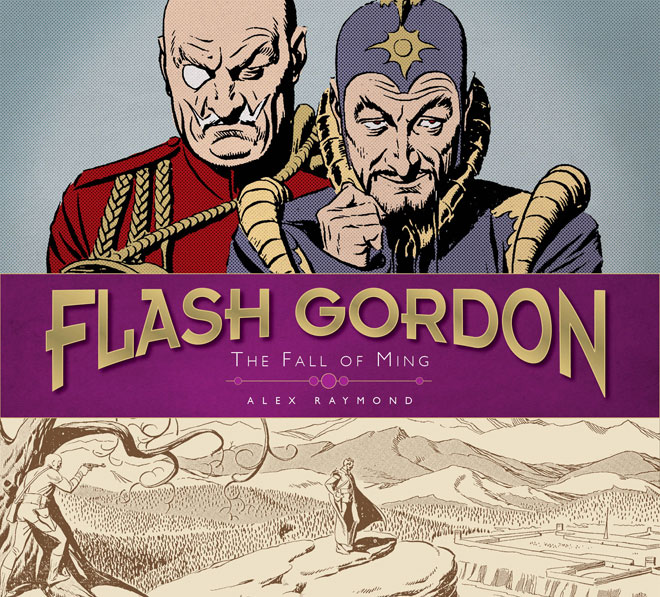
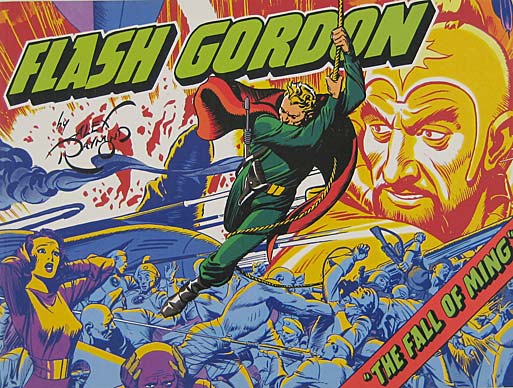 “The Fall of Ming” was the fifteenth installment of Alex Raymond’s Flash Gordon Sunday comic strip serial for King Features Syndicate. Originally published between January 19 and June 29, 1941, “The Fall of Ming” picks up the storyline where the fourteenth installment, “The Power Men of Mongo” left off with Flash having reached the gates of Ming’s concentration camp in a daring attempt to rescue Zarkov and the other political prisoners held there. Bulon is just about to assassinate Flash when he is captured by Ming’s guards. The traitor quickly reveals Flash’s hiding place. Flash barely escapes with his life, but later succeeds in infiltrating Ming’s “death patrol.”
“The Fall of Ming” was the fifteenth installment of Alex Raymond’s Flash Gordon Sunday comic strip serial for King Features Syndicate. Originally published between January 19 and June 29, 1941, “The Fall of Ming” picks up the storyline where the fourteenth installment, “The Power Men of Mongo” left off with Flash having reached the gates of Ming’s concentration camp in a daring attempt to rescue Zarkov and the other political prisoners held there. Bulon is just about to assassinate Flash when he is captured by Ming’s guards. The traitor quickly reveals Flash’s hiding place. Flash barely escapes with his life, but later succeeds in infiltrating Ming’s “death patrol.”
Dale makes a full recovery and learns from Rena that Bulon is plotting against Flash. The two girls defy Ergon’s orders and set out to rescue Flash. Dale is captured by Sergeant Mordo, one of Ming’s patrolmen while Rena manages to escape. Dale is sent to the concentration camp, but Flash soon learns of her arrival and sets out to rescue her.
Alex Raymond again pushes the boundaries of 1940s sensibilities in the panel showing the muscular and unattractive female guards stripping Dale of her clothing. Likewise, his efforts to show the brutality of German concentration camps proves effective on an entirely different level. The camp’s warden Terro is depicted as a monocled Aryan monster (admittedly, Mongo is also filled with other politically incorrect caricatures from insidious Asians to traitorous Semitic characters as was common in the pulp fiction of the era). Raymond shows many of the prisoners with shaved heads, half-starved, and regularly beaten by the abusive warden. He also depicts a nubile young woman with her back being broken on a wheel. Don Moore’s script notes that prison cells are designed to prevent inmates from standing straight or being able to sit or lie down in an attempt to drive them mad. Raymond was obviously outraged by the War in Europe and was doing the best he could to draw readers’ attention to it by making Ming’s heinous actions strongly parallel Hitler’s atrocities that were recounted in newspapers of the day.
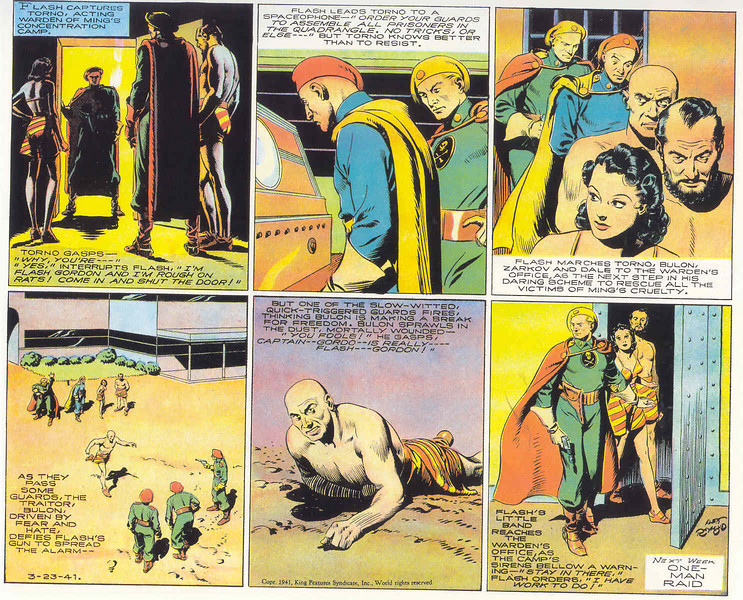
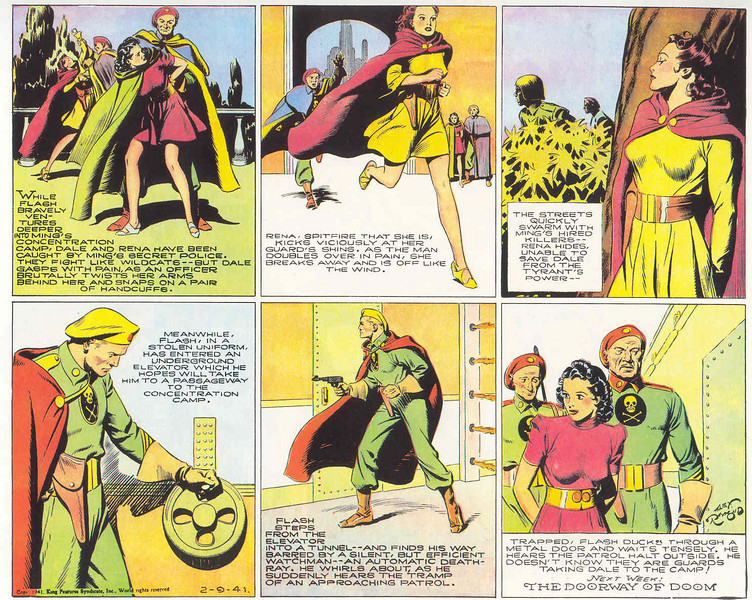 Flash, posing as Captain Gordo of Ming’s Secret Police demands Dale and Zarkov be released for questioning. Unfortunately, Bulon spies Flash from his cell and warns Terro. Zarkov again proves he is capable by overcoming the warden. Flash releases all of the prisoners in the cell block. They viciously beat the traitor, Bulon. Terro is bound and gagged and Flash takes his assistant, Torno hostage. Bulon is shot and killed as an escaped prisoner while warning the guards that Flash is posing as Captain Gordo of the Secret Police. The alarm is sounded after Flash orders all of the prisoners released and assembled in the quadrangle. Braving a rain of bullets from the prison guards, Flash succeeds in leading an uprising by the unarmed prisoners against their guards.
Flash, posing as Captain Gordo of Ming’s Secret Police demands Dale and Zarkov be released for questioning. Unfortunately, Bulon spies Flash from his cell and warns Terro. Zarkov again proves he is capable by overcoming the warden. Flash releases all of the prisoners in the cell block. They viciously beat the traitor, Bulon. Terro is bound and gagged and Flash takes his assistant, Torno hostage. Bulon is shot and killed as an escaped prisoner while warning the guards that Flash is posing as Captain Gordo of the Secret Police. The alarm is sounded after Flash orders all of the prisoners released and assembled in the quadrangle. Braving a rain of bullets from the prison guards, Flash succeeds in leading an uprising by the unarmed prisoners against their guards.
It is clear that Raymond was eager to impress upon his readers the need for hostages or political prisoners to overcome their natural fear of individual death to allow greater numbers to triumph over their captors. This tragic aspect of the abomination that was the Holocaust is one that is repeated time and again in hostage situations around the world. The lesson of resistance with unarmed captives rising over the armed captors they greatly outnumber is crucial to embrace. Sadly, the real life inmates of concentration camps were starved into submission to prevent this possibility from being realized, but Raymond was likely unaware of the full horror of the Nazi atrocity.
Knowing that the element of surprise has only bought them limited time before the superior firepower is brought to bear against the unarmed numbers, Dale and Zarkov lead the prisoners to escape through the underground tunnel system. Dale joins Flash in staying behind to hold off the guards with his rifle until the prisoners have escaped. They are overcome with tear gas. Ming personally arrives at the camp. The Emperor’s fury over the liberation of the camp is assuaged by learning that Flash and Dale have finally been captured. Ming declares they are sentenced to death by torture the next day. Flash gives Dale a suicide pill that Zarkov provided him. Unimaginable in today’s comic strips, readers of the April 20, 1940 installment witnessed Flash and Dale’s death by suicide. A furious Ming orders their corpses be placed on display as a deterrent to rebellion. Rena pleads with Ergon to retrieve their bodies and give them the proper burial they deserve.
The next week’s installment sees Zarkov explain to Ergon that the pills were only catalepsy-inducing pills, not suicide pills. An angry uprising of outraged citizens appears in the streets of Mingo City. Ming ignores the warning of his general not to antagonize the mob further by displaying the rebels’ corpses in public. Ming orders his tanks to the streets of the city to mow down the protesters. All thought of comic strip fantasy is lost in the harsh totalitarian reality of these strips. Raymond and Moore were determined to portray Ming as a menace whose reign of terror had to end.
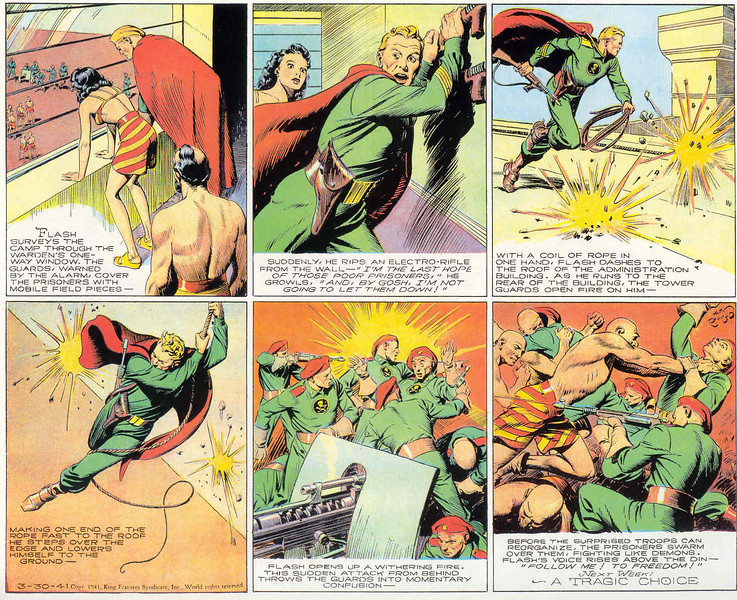 Ming’s success in putting down the revolution seems the crowning achievement of his infamous career. Zarkov and Ergon break into the tomb and revive Flash and Dale. Flash, Zarkov, and Ergon waste little time and use the power tunnel to gain entrance to the Emperor’s bedroom at night. Ming is gagged and bound and Zarkov administers a drug that allows the Emperor to easily be hypnotized. Under Flash’s hypnotic influence, Ming makes a startling radio announcement that he has abdicated with Flash ruling Mongo in his place before slipping into a coma. Flash appoints the Freemen to be his personal guard. Ming’s Secret Police are sent to concentration camps. Mingo City is overtaken by a celebratory carnival as the citizens rejoice at their newfound freedom.
Ming’s success in putting down the revolution seems the crowning achievement of his infamous career. Zarkov and Ergon break into the tomb and revive Flash and Dale. Flash, Zarkov, and Ergon waste little time and use the power tunnel to gain entrance to the Emperor’s bedroom at night. Ming is gagged and bound and Zarkov administers a drug that allows the Emperor to easily be hypnotized. Under Flash’s hypnotic influence, Ming makes a startling radio announcement that he has abdicated with Flash ruling Mongo in his place before slipping into a coma. Flash appoints the Freemen to be his personal guard. Ming’s Secret Police are sent to concentration camps. Mingo City is overtaken by a celebratory carnival as the citizens rejoice at their newfound freedom.
Ming recovers sooner than expected and escapes by murdering his guard. While the Power Men hunt for Ming, the deposed Emperor reunites with the head of his Secret Police, Golob, who has gone into hiding to avoid being sent to the concentration camp. Together they manage to reach General Bravor’s headquarters and attempt to regain control of the army. Flash arrives at Bravor’s headquarters and quickly overpowers Ming. Golob is shot dead by Bravor’s right hand man, Major Darin just as Golob is about to shoot Flash in the back. Flash has Darin promoted to Colonel for his bravery. Mongo is reorganized as a Republic founded on the principles of Freedom and Justice for all as Flash, Zarkov and Dale triumphantly announce the next day during a radio broadcast.
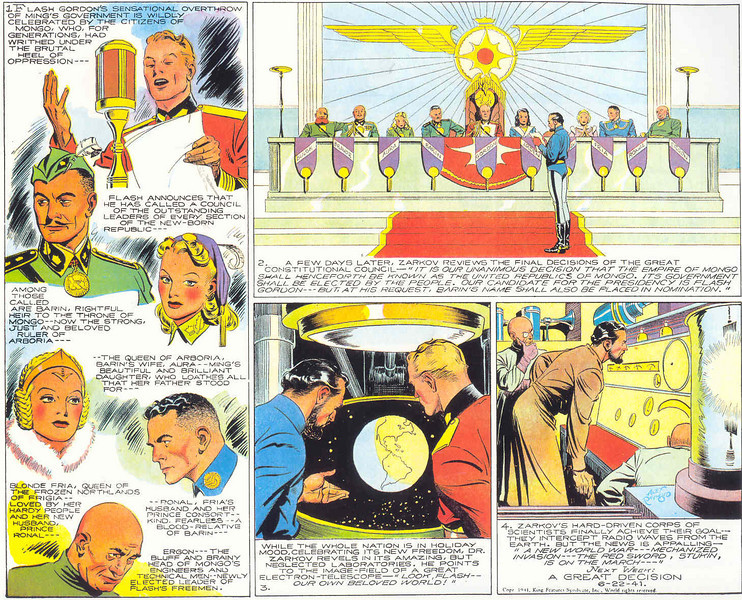 Flash forms a Constitutional Council consisting of King Barin and Queen Aura of Arboria; Queen Fria of Frigia and her royal consort, Prince Ronal; Ergon, leader of the Power Men, along with Bulok, Bravor, Dale and Zarkov. The Council establishes the United Republics of Mongo in place of the former Empire. The government will consist of elected officials. Flash is nominated for president by the council, but he refuses and insists on Barin as the council’s candidate.
Flash forms a Constitutional Council consisting of King Barin and Queen Aura of Arboria; Queen Fria of Frigia and her royal consort, Prince Ronal; Ergon, leader of the Power Men, along with Bulok, Bravor, Dale and Zarkov. The Council establishes the United Republics of Mongo in place of the former Empire. The government will consist of elected officials. Flash is nominated for president by the council, but he refuses and insists on Barin as the council’s candidate.
Zarkov succeeds in establishing radio communication with Earth but is shocked to learn that a Second World War has broken out due to the Invasion of the Red Sword. Torn by the knowledge that they have liberated Mongo at last only to learn that a second and worse World War is raging back home on Earth, the trio realize they must return immediately. Mongo’s finest scientists aid Zarkov in constructing a new rocket ship to carry them back to Earth to combat the menace of the Red Sword. Flash says a tearful farewell to his old friend, Barin at the air field while he prepares to board the rocket ship to return back to Earth with Dale and Zarkov.
So ends the first great story arc in the strip’s celebrated run with Alex Raymond and Don Moore succeeding in mirroring real life events on Earth as closely as possible without sacrificing entertainment. Their work remains without peer and the strip’s influence is still felt today in Star Wars and countless other properites. Their classic original run remains in print for a new generation to enjoy from Checker Books, Titan Books, and IDW. If you have never sampled the seminal brilliance of this finest of all adventure fantasy strips, I urge you to take advantage of the treasure being preserved by one of the three current license holders and thrill to a simpler time whose echoes have not been dimmed by the passage of another century.
William Patrick Maynard was authorized to continue Sax Rohmer’s Fu Manchu thrillers beginning with The Terror of Fu Manchu (2009; Black Coat Press). A sequel, The Destiny of Fu Manchu is due for publication in early 2012 by Black Coat Press. Also forthcoming is a collection of short stories featuring an original Edwardian detective, The Occult Case Book of Shankar Hardwicke and an original hardboiled detective novel, Lawhead. To see additional articles by William, visit his blog at SetiSays.blogspot.com